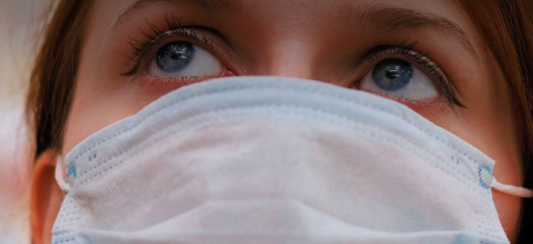
Our friends at Klein and Partners and The DRG just published the third wave of their Coronavirus Omnibus research — How the Coronavirus is Impacting Healthcare Perceptions and Behaviors. The healthcare market research study was fielded in mid-June 2020 with a random sample of 511 adults across the U.S. This is an update of the May 2020 research on which we recently reported. Following are the most notable highlights regarding what has changed since the previous wave. The full study is available for download here.
As in the previous wave of the study, hope, optimism and inspiration outweighed the anxiety, loneliness, anger and fear felt by consumers, which were relatively moderate — ranging from 4.3 to 5.2 on a ten-point scale. In spite of a growing number of people with a friend or family member with COVID-19, levels of each of these emotions declined significantly from the prior wave, among consumers.
Meanwhile, consumer levels of concern about personal safety, a household member getting the Coronavirus and their financial situation, among other things, declined slightly. Concern about rescheduling appointments and seeking non-Coronavirus care at various types of healthcare facilities remained essentially unchanged.
Among healthcare workers (new to this wave), the positive emotions (hope, optimism and inspiration) were even higher than among consumers. However, anxiety (7.5), loneliness (7.1), anger (6.9) and fear (6.9) were also concerningly — though perhaps not surprisingly — high.

Rob Klein, the researcher, poses the right question in the report: “As an industry, how can we help our front line caregivers get through this emotionally?” What more can we do to support clinician mental health, ease burnout, and help them feel less anxious and alone? Can we make mental health support more accessible for them? How can we provide additional respite?
Virtual care continues to be a vital and growing channel for access to care. In this third wave of the study, 22% of consumers said they used a virtual visit for the first time during the Coronavirus, compared to 12% just a month ago. One in 10 (11%) reported using a virtual mental health session for the first time, compared to 7% in the prior wave. Even more said they will “definitely” use virtual visits (29%) and virtual mental health sessions (21%) after the Coronavirus.
The study also illuminated how crucial it is for physician offices and scheduling staff to effectively offer virtual visits, versus relying only on a marketing push. Among those who had a recent virtual visit, 40% first learned about it either through their doctor’s office providing the options when their in-person appointment was cancelled or through virtual care being offered when they called to make a new appointment. At the same time, a significant number did report learning about it through marketing communications channels, including social media (9%), the news/an article (8%), a doctor’s website (6%), Google search (5%), advertising (4%), email (4%) and a hospital/system’s website (3%).
One of the most immediately useful findings in the research for healthcare marketing communications is the quantitative clarity it provides with regard to the barriers that exist to telehealth among those who have not tried it and are not sure they will. As we expected based on other research, the top concern was that virtual care is simply too impersonal, so the person wants to see the doctor in person (25%). Another fourth (23%) don’t know enough about it yet. A significant proportion (22%) see no need because they can always get into their doctor. A fifth (21%) don’t trust the quality of online care. Some (13%) are concerned about online privacy. So, we all have a lot of work to do to educate people about how personal and high quality virtual visits can be.

In a webinar discussion of this research, Rob Klein noted that some health systems are offering patients their first virtual visit — perhaps just a quick connection with their physician — free of charge, to demonstrate its effectiveness to consumers. This is an excellent approach for all systems to consider, to drive increased adoption and gain market share in the crucial early stages of adoption before local consumers become entrenched with another virtual care provider.
Mental health, of course, is a serious concern for clinicians and consumers alike. Some consumers (8%) had to cancel a mental health session due to the Coronavirus. While 60% of them were able to reschedule their appointment (31%) or change it to a virtual visit (29%), 40% were waiting to reschedule, unable to reschedule, or don’t plan to reschedule.
At the same time, a whopping two thirds of all consumers surveyed said they have an immediate need to be seen for a condition related or potentially related to mental health, including stress and anxiety, depression, hypertension, headaches, weight gain, sleep issues, and drug and alcohol abuse. We wholeheartedly agree with Rob Klein’s assessment that having an effective mental health strategy is urgent, for systems to help people get back to health as a whole person.
In addition to these immediate mental health-related concerns:
In total, nearly six in 10 (57%) adults across the U.S. said they have some immediate health need. So, there is pent up need and demand, as soon as health systems are able to supply it. To the extent possible under current financial pressures, it would be wise for systems to stay in the market with a presence behind these key service lines.

In his webinar detailing the study findings, Rob cited “empathetic access” as the mantra for moving forward. We think this is an excellent summation of how to meet consumers where they are now.
As in the prior wave, one in five consumers said they would switch providers if their current provider lacked empathy for their current situation. Another fifth would switch if their provider was difficult to work with in getting rescheduled. And, while access to care has improved since a month ago, many consumers continue to wait to reschedule annual physicals (35% of those with cancelled appointments), screening tests (52%), consult visits (38%), elective procedures and surgeries (26%) and sick care visits (25%). Hence, the call for empathetic access.

With even the moderate levels of anxiety, fear, anger and loneliness reported by consumers, certainly high empathy at all points of contact with health care systems is quite needed. Yet, with caregivers feeling even higher amounts of these draining emotions, it’s likely getting harder and harder for them to be empathetic, constantly. As we all know, caregivers are doing a phenomenal job of it, and consumers agree. When asked how well healthcare providers are handling “recognizing and caring for people’s heightened emotions when seeking care,” the average consumer rating was 7 out of 10, and rising, as were “helping you stay calm if you think you are symptomatic” and “making you feel safe if you come in for care.”

Sue Spaight is the Director of Insights and Strategy at Core Health, Core Creative’s specialized healthcare marketing practice. Core Health connects its clients with solutions that help their audiences live fuller, healthier, more purposeful lives.
The original version of this page was published at: https://health.corecreative.com/insights/updated-insights-on-how-the-pandemic-is-affecting-consumer-and-caregiver-behavior/
Core Creative is an award-winning strategic creative agency driven by a Boundless Pursuit of Better. Better creativity. Better cultures and communities. All to help others live their calling. We be... Read more
While facts and figures have their place, effective storytelling helps your marketing leave a lasting impression.If you’re not a creative type, “show, don’t tell,” ...read more
Quick ideas for navigating media in today’s marketThere’s no doubt healthcare communicators are feeling the pressure during the COVID-19 pandemic. Healthcare marketing ...read more
Why and how to infuse more empathy in your healthcare marketingLately, everywhere I look — research studies, articles and books — the word “empathy” keeps popping ...read more
Using digital tools to engage more patients in their careAlyssa Carter, director of marketing at Wellsource, and Laila Waggoner, Core Health’s senior healthcare strategist, roll ...read more

the Touch Point podcast
Hear the latest from industry experts on healthcare marketing and digital experience strategies in this weekly podcast.